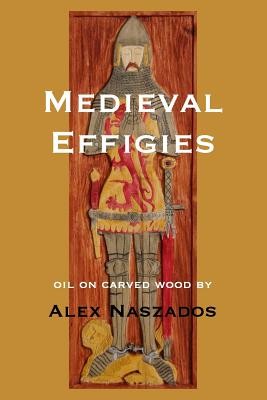
- Išsiųsime per 10–14 d.d.
- Autorius: Alex Naszados
- Leidėjas: Blurb
- ISBN-10: 0368988813
- ISBN-13: 9780368988813
- Formatas: 15.2 x 22.9 x 0.3 cm, minkšti viršeliai
- Kalba: Anglų
- Extra -25 % nuolaida šiai knygai su kodu: ENG25
Atsiliepimai
Aprašymas
An exhibit called "Medieval Effigies" (shown at Deer Park Library, Toronto, during July, 2019) comprised the nineteen pieces in this catalogue.
With one exception*, they are directly inspired by medieval funerary brasses. More technically, I mostly referred to rubbings of these brasses, since they usually provide more contrast and clarity. Moreover, these rubbings are widely available in various published catalogues.
Facing each colour plate is a thumbnail of the corresponding rubbing I used as a reference. In addition, the location of the tomb is given. Some also include a QR code, which links to a short video. The videos either explore an interesting detail, or simply show the location of the brass.
You will notice that most of the brasses here are located in the United Kingdom. This is reflective of the fact that a greater number of brasses have survived there, even though such effigies were once more common all over Europe. I also tried to represent various segments of medieval society: nobility, clerics, merchants, knights, royalty etc... Usually, individuals were depicted as they would have appeared during life. In a minority of cases however, individuals chose a macabre depiction of their decomposing corpse. Since brasses were often commissioned well before the subject's death, this would serve as a sobering memento mori. An example of this is Ralph Hamsterley (p 42), whose skeletal remains are depicted infested with worms.
*Note: The image of the anchoress, Julian of Norwich, (p 26), is the one piece not derived from a brass. It is based on a painting in the church of SS Andrew and Mary, Langham, Norfolk.
EXTRA 25 % nuolaida su kodu: ENG25
Akcija baigiasi už 3d.19:18:41
Nuolaidos kodas galioja perkant nuo 10 €. Nuolaidos nesumuojamos.

- Autorius: Alex Naszados
- Leidėjas: Blurb
- ISBN-10: 0368988813
- ISBN-13: 9780368988813
- Formatas: 15.2 x 22.9 x 0.3 cm, minkšti viršeliai
- Kalba: Anglų Anglų
An exhibit called "Medieval Effigies" (shown at Deer Park Library, Toronto, during July, 2019) comprised the nineteen pieces in this catalogue.
With one exception*, they are directly inspired by medieval funerary brasses. More technically, I mostly referred to rubbings of these brasses, since they usually provide more contrast and clarity. Moreover, these rubbings are widely available in various published catalogues.
Facing each colour plate is a thumbnail of the corresponding rubbing I used as a reference. In addition, the location of the tomb is given. Some also include a QR code, which links to a short video. The videos either explore an interesting detail, or simply show the location of the brass.
You will notice that most of the brasses here are located in the United Kingdom. This is reflective of the fact that a greater number of brasses have survived there, even though such effigies were once more common all over Europe. I also tried to represent various segments of medieval society: nobility, clerics, merchants, knights, royalty etc... Usually, individuals were depicted as they would have appeared during life. In a minority of cases however, individuals chose a macabre depiction of their decomposing corpse. Since brasses were often commissioned well before the subject's death, this would serve as a sobering memento mori. An example of this is Ralph Hamsterley (p 42), whose skeletal remains are depicted infested with worms.
*Note: The image of the anchoress, Julian of Norwich, (p 26), is the one piece not derived from a brass. It is based on a painting in the church of SS Andrew and Mary, Langham, Norfolk.




Atsiliepimai